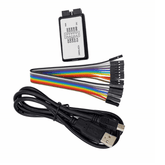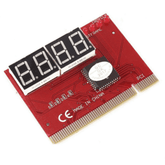What is Ultrasonic Sensor: Working Principle & Applications
What is Ultrasonic Sensor?

The Ultrasonic Sensor is an electronic device that calculates distance by emitting sound waves and collecting their echoes.
It can measure objects from up to 4.5 meters away, which makes it a versatile instrument for correctly measuring both short and long distances without making contact with the target object, which is critical in many applications such as obstacle avoidance systems in robotics or autonomous cars.
The sensor features adjustable pulse widths, allowing for higher resolution measurements when set at lower levels though this comes at the cost of range accuracy diminishing as a result, however, due to its affordability compared to other forms of distance sensing technologies makes it incredibly suitable where budget constraints are paramount factor within projects evaluating solutions using ultrasonic technology.

Ultrasonic sensors are used as proximity sensors. They are used in parking technologies and anti-collision safety systems. Ultrasonic proximity sensors are also employed in automated obstacle detection systems and factory engineering.
Compared to infrared (IR) sensors in proximity sensing applications, ultrasonic sensors are less susceptible to interference from smoke, gases, and other airborne particles (although the physical component is subject to variables such as heat).
Ultrasonic sensors are not just used to measure liquid levels in containers, they also enable doctors to view inside organs, identify cancer, and monitor babies in the womb.
Working Principle of Ultrasonic Sensor?
An ultrasonic sensor is a type of electronic sensor that uses ultrasonic waves to determine the distance between two objects and converts the reflected sound into electrical signals.
The working principle of an ultrasonic sensor is to measure distance using ultrasound, which travels faster than sound that is audible. This sensor consists of two major components a transmitter that generates sound waves via a piezoelectric crystal and a receiver that detects the reflected ultrasonic waves.

While some sensors have separate sound emitters and receivers, the two functions can be combined into a single device by using an ultrasonic element that alternates between sending and receiving signals in a continuous loop.
The transmitter of the module transmits an ultrasonic sound. This sound will be reflected if an object is present in front of the ultrasonic sensor. The reflected sound is received by the receiver present in the same module.
An ultrasonic signal is propagated by a wave at an angle of 30°. The above-depicted Figure illustrates how the ultrasonic signal propagates from the transmitter. Measuring angles should be at least 15° for maximum accuracy.
In this case, external objects that fall under this measurement angle interfere with determining the distance to the desired object.
The distance is calculated by measuring the ultrasonic sound's travel time and speed.
Distance = Time x Speed of sound / 2
Example:
Assume you are working on a project for Arduino powered garage parking sensor. You choose to include sensors in the design to ensure car detection while parked.
Ultrasonic sensors are carefully installed at each parking spot in the lot. When cars enter the parking lot, they pass by rows of distance measuring sensors.
When a vehicle passes by an ultrasonic sensor it emits a frequency sound wave, in response. This wave reflects off the car. Returns as an echo to the sensors transducer, which acts as both sender and receiver.
The sensor then calculates the time taken for the wave to travel back and forth from the vehicle. Given that the sound's velocity is known, it can accurately determine the distance, between itself and the car.
Reflection of the sensing sound varies with configuration, for example

(A) Flat objects: liquid, box, plastic sheet,
(B) Columnar objects: can, bottle, the human body,
(C) Granular objects: ores, rock, coal, coke, plastic pellet,
To generate the ultrasonic sound, need to trigger the trigger pin as high for a minimum of 10us. Then the module will start sending 8 sonic burst ultrasounds from the module at 40 kHz.
It will be received by the receiver called Echo pin and it will calculate the output time to measure the distance.

To prevent mutual interference between Ultrasonic Sensors, the synchronous operation can be used by emitting the ultrasonic waves from each Sensor simultaneously.

Specifications:
- Supply voltage +5 V;
- Consumption in silent mode 2 mA;
- Consumption at work of 15 mA;
- Measurement range - 2 to 400 cm;
- Effective measuring angle 15°;
- The dimensions are 45×20×15 mm.
Read our blog on how to connect ultrasonic sensor to Raspberry Pi where we discuss the complete process of Interfacing HC-SR04 with Raspberry Pi.
How are Ultrasonic Sensors used?
With microcontroller platforms like the Raspberry Pi, ARM, PIC, Arduino, Beagle Board, and many more, our ultrasonic proximity level and distance sensors are often employed.
Ultrasonic sensors will send sound waves in the direction of the target and calculate its distance by timing how long it takes for the waves to bounce back to the sensor. In addition, collision avoidance systems also employ ultrasonic sensors.
Before interfacing, let us see the pinout of the ultrasonic sensor,

Four pins in the sensor
Vcc |
power supply +5 V |
Gnd |
Common ground |
Trigger pin |
To start the sensor |
Eco pin |
Receive the signal |
Use multiple sensors to avoid interference
When using multiple sensors in an application, it is important to connect them in a way that avoids problems such as crosstalk and other interference.
It is important to keep the front of the ultrasonic transducer clear to avoid interference with the ultrasonic signal from the sensor.
Check out our complete guide on Arduino Interfacing with Ultrasonic Sensor
How to Connect Ultrasonic Sensor to Arduino:
Before going to the steps you need to ensure that you have the following Hardware.
- Arduino Board (You can use any Arduino Board)
- HC-SR04 Ultrasonic sensor
- Jumper cables
Steps for Arduino Interfacing with Ultrasonic Sensor:
Step 1: Make all the connections properly as per the diagram shown in the image below.

Step 2: Now open Arduino IDE or you can Install Arduino Sketch coding software on your desktop and type the below code.
#define echoPin 6
#define trigPin 7
long duration;
int distance;
void setup()
{
pinMode(trigPin, OUTPUT);
pinMode(echoPin, INPUT);
Serial.begin(9600);
}
void loop()
{
digitalWrite(trigPin, LOW);
delayMicroseconds(2);
digitalWrite(trigPin, HIGH);
delayMicroseconds(10);
digitalWrite(trigPin, LOW);
duration = pulseIn(echoPin, HIGH);
distance = duration * 0.034 / 2;
Serial.print("Distance: ");
Serial.print(distance);
Serial.println(" cm");
}
Step 3: Now connect your Arduino Board to the PC by using an Arduino USB cable.
Step 4: Now select the correct board by simply going to Tools >> Boards >> Arduino AVR Boards >> Arduino UNO.
Then select the correct port by going to Tools >> Ports >> Port where the Arduino board is connected. You can make it sure by check in the device manager.

Step 5: After selecting the correct port and board just click on the upload icon.
Now you are ready to see the distance measurement by an ultrasonic sensor on serial monitor.
Advantages of Ultrasonic Sensors
- Ultrasonic sensors are a fantastic tool for measuring the distance, speed, and position of things. They provide greater accuracy than traditional technology, such as lasers or infrared sensors.
- The ultrasonic wave is generated through a transducer that sends out high-frequency sound waves, which travel faster than the speed of light due to their higher frequency range (ultrasonics is in the kilohertz range).
- These sensors enable manufacturers and engineers for detailed detection over wide ranges with minimal complexity involved when setting up certain systems; they can even detect objects at distances greater than 200m away accurately!
- Ultrasonic sensors also do not rely on visible light like other types of technology so they can be used indoors/outdoors without worrying about environmental conditions affecting performance levels - this makes them ideal for use in dark areas or lowlight situations where visibility would otherwise be compromised by regular sensing techniques
- These devices have self-diagnostics capabilities, allowing users quick access to system status by checking errors & fault codes and reading back calibration parameters, thus providing easy maintenance routines.
- With no external power source needed, these types of tools operate more reliably with less downtime, thus leading to improved productivity levels across applications relying heavily on their usage, ranging from robotics automation, industrial monitoring, security surveillance activities, etc.
Limitations of Ultrasonic Sensors
- Ultrasonic sensors have a limited range, which makes them less effective when larger distances need to be covered or detected.
- They are prone to interference from other sources and can provide false readings due to these interferences, including reflections off of non-metallic objects that may not be correctly identified by the sensor’s recognition capabilities.
- Response times for ultrasonic sensing technology are relatively slow in comparison with some other types of distance measurement equipment, such as infrared devices, meaning they take longer periods of time before an accurate reading is provided back on screen, making it inconvenient where fast responses are needed immediately upon detection.
- High-density materials, extreme temperatures and small target surfaces are also unable to be detected properly using ultrasonic sensors since their performance gradually reduces under those conditions, leading them to underestimate the actual values being measured within their vicinity environment.
Applications of Ultrasonic Sensor
5 Uses of Ultrasonic Sensor
Ultrasonic Anemometers:
In weather stations, ultrasonic anemometers provide accurate measurements of wind direction and speed. While 2D anemometers deal with horizontal winds, 3D anemometers involve a vertical component.
These advanced equipment tracks differences in temperature as well as changes in ultrasonic velocity, giving weather forecasters an in-depth understanding of the weather.
Tide Gauge:
Using ultrasonic sensors to quickly detect water levels, the tide gauge is a crucial tool for monitoring sea levels and identifying a variety of coastal events, such as waves, water surges, tsunamis, and floods.
Sometimes these measures are incorporated into online databases, which allows timely notifications for potential sea dangers and simplifies record administration.
Tank level:
Measuring liquid levels in tanks is similar to using a level meter. However, in this scenario, the fluid could be freshwater, corrosive chemicals, or flammable liquids.
Ultrasonic sensors, unlike optical sensors and float switches, do not come into contact with liquids, hence they are less prone to corrosion.
Web-guiding systems:
Web-guiding systems ensure accurate material placement. If the material is mismatched, the system will mechanically move it back into the machine path.
Ultrasonic sensors are well suited for web guiding, as the process requires non-contact, fast and efficient functionality.
UAV navigation:
Unmanned Aerial Vehicles (UAVs) (or drones) typically use ultrasonic sensors to monitor objects in their flight path and the UAV's distance from the ground.
By automatically detecting safe distances, aircraft can avoid collisions. In addition, since the flight path changes in an instant, drone collision can be prevented by detecting the distance with ultrasonic waves.
Conclusion
This blog post has informed us about the working principle of ultrasonic sensors, which are a very flexible technology with a wide range of real-world uses. Gaining knowledge about the fundamentals and operations of these sensors will enable you to fully understand the variety of advantages they provide, ranging from automation and security to scientific and medical research.
You may open up a whole new world of possibilities and advance your projects by utilizing the power of an ultrasonic range finder. Why not learn more about the exciting field of ultrasonic sensors and see how they might improve your work right now?
If you appreciate our work, don't forget to share this post and leave your opinion in the comment box.
Please do check out other blog posts about Popular electronics
Make sure you check out our wide range of products and collections (we offer some exciting deals!)






